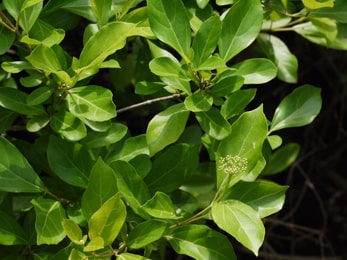AGNIMANTHA (CLERODENDRUM PHLOMIDIS) - PROPERTIES, BENEFITS, USES & DOSAGE

DESCRIPTION OF AGNIMANTHA PLANT
Agnimantha is very important medicinal plant mentioned in texts since Vedic period. It is described as one of the ten herbs of Dashamoola. Agni means fire and mantha means to shake and its wood is rubbed together to produce fire in ancient times. This herb is best Vatahara and Shothahara according to Acharya Charak. Agnimantha is a flowering plant in Lamiaceae / vibernaeceae family. It resembles like large shrub or small trees growing up to 9 meters in height. It is found with yellow bark and brown colored woody aromatic root. It is small herb commonly distributed in India and Sri Lanka. It grows along with other plants in a group. It has simple, ovate, opposite, membranous and irregularly toothed leaves. Flowers of this herb are small white colored with unpleasant smell. Fruits are saucer shaped calyx that surround the base, black when ripened.
Largely known variety is called Agnimantha and less known variety is called tarkari. 2-3 herbs are used in the name of Agnimantha.
- Clerodendrum phlomidis
- Premna mucronata/Premna corymbosa
Chemical composition of Clerodendrum phlomidis contains pectolinarigenin, hispidium, cleodendrin, raffinosa etc.
Premna mucronata is B-sitosterol, lutoelin, premnine, botulin, ganikarine, premenol and ganiarine.
SPECIAL NOTE ABOUT AGNIMANTHA
Agnimantha, Jaya, Vataghni and Sriparna are the various names of this herb because of its various features.
अग्निं मध्नाति दीपनत्वात् अग्निमन्थ:
When sticks of Agnimantha are rubbed together they produce fire that is why it is called Agnimantha.
It helps to overcome various diseases and called jaya.
Helps to pacify vata dosha thus called vataghan.
Due to very beautiful appearance of leaves it is called Sriparna.
HABITAT OF AGNIMANTHA
Agnimantha is widely distributed throughout India. It is found mostly in dried parts. It is easily available in upper Gangetic plains, Uttar Pradesh, Bihar and Orissa etc. it is also easily available in coastal areas of southern India and dry regions of western coast. It is also found in banks of ganges and Bengal. Flowering season of this plant is from April to June.
CLASSIFICATION
- Family - Verbenaceae (Nirgundi kula)
- Order - Lamiales
- Kingdom - Plantae
NAMES
- Latin name - Clerodendrum phlomidis
- Sanskrit name - Agnimantha
- Hindi - Tekar, Arni, Agathu, Ganiyari,urni
- Malayalam - Munja
- Bengali - Ganiyari, Ganira
- Kannnad - Arani, Aranel, Airanamula
- Oriya - Ganiary
- Telgu - Nelli, Gabbunulli, Taluki
- French name - Arbe a la migraine
- Tamil name - Tazhutazhai, Munnay
PROPERTIES
| Hindi / Sanskrit | English | ||
| Rasa | Katu, Tikta, Kashay, Madhur | Taste | Pungent, Bitter, Astringent, sweet |
| Guna | Laghu, Rooksha | Physical Property | Light, Dry |
| Virya | Ushna | Potency | Hot |
| Vipaka | Katu | Metabolic Property (After Digestion) | Pungent |
EFFECTS ON DOSHA
It balances vata and kapha.
| Charak Samhita | References |
| Shonakadi lepa | cha.chi.27/57 |
| Baladi lepa | cha.chi.21/125 |
| Agruwadi taila | cha.chi.3/269 |
| Agstya haritaki | cha.chi.18/62 |
| Agnimanth swarasa | cha.chi.21/24 |
| Dashmoola kwath | cha.chi.17/105 |
| Sushrut samhita | References |
| Aushadheeya ayaskrti | Su.chi.10/3 |
| Panchmooladi ghrita | Su.chi.26/5 |
| Dashmoola Ksheera basti | Su.ut |
| Dwipanchamoola kwatha | Su.ut.40/144 |
| Bilwadi sura | Su.ut |
RAJNIGHANTU
According to rajnighantu there are two types of Agnimantha:-
- Brhat Agnimantha
- Laghu Agnimantha
Botanical name of Agnimantha is Premna mucronata. Rasa of this herb is katu and tikta and virya is ushna. Effect of herb on dosha is kpahavataghna. It is used in various disease like Shotha and shola, pandu, Arsha, Shleshma, Agnimandya and Adhmana.
ANCIENT VERSE

According to this shalok Agnimantha, jay, sreeparni, ganikarika, jaya, jayanti, tarkari, nadya and vayjanti are the synonyms of this herb. This herb is anti-inflammatory (shoth nashak), hot potency (ushan veerya), pacifies vata and kapha (kapha vata hara). It is pungent (katu), bitter (tikat), astringent (kashay) and sweet (madhur) rasa and It is fire productive (deepan karma) in nature. It is best used to treat anemia (pandu roga).
REFERENCES:-
- The CHARAK SAMHITA - Achrya charka considered Agnimantha as shothhar, sheetprashmana and anuvasanopaga ganas.
- The SHUSHRUT SAMHITA - Acharya shushruta catagorized this herb under many ganas. Agnimantha is included under varunadi, vatashamna and viratarvadi gana.
- ASHTANG HRIDAY – In astang hirday arani word is used to describe Agnimantha. Its indication is for vataj vayadi, ashmari and mutraghata.
- VAGBHATA - Vagbhata considered this herb under varunadi and viratarvadi gana.
PRACTICLE USES OF CLERODENDRON PHLOMIDIS
- Agnimantha is best useful in anemia.
- It pacifies kapha (kaphaghna).
- Used to reduce swelling and inflammation (Shothahara). Warm leaves of Agnimantha are used to relieve severe pain.
- Agnimantha is useful for low digestive fire (Agnimandya) and improves digestive fire (deepana).
- Used to expel out extra waste from body (anulomana).
- Helpful in treating diabetes (premhaghna). Decoction of roots has anti-diabetic properties.
- It is used to treat haemorrhoids (arsha), cough (kasa) and asthma (swasa).
- Useful in urinary tract infection.
- Boost the immune system and purify blood (rakta shodhaka).
- Known for its analgesic properties and anti-pyretic properties (jawarghna).
- It is analgesic (Vednasthapan).
- Decoction of root is used in painful micturition.
- Pulp of roots are given orally to treat Urticaria and other skin disorders.
DOSAGE
- Mool churna - 1-3 gm
- Kwatha - 50 - 100 ml
- Patra swaras - 10 - 20 ml
PART USED
Root bark, bark, panchang and leaves.



